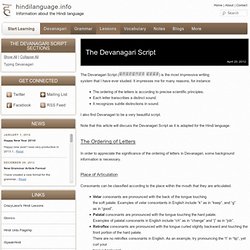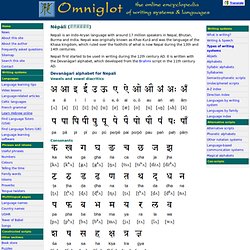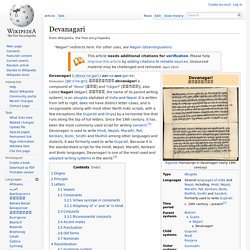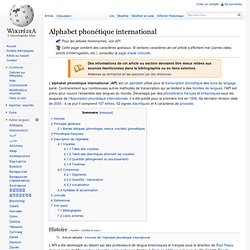

The Devanagari Script. The Devanagari Script (देवनागरी लिपि) is the most impressive writing system that I have ever studied.

It impresses me for many reasons, for instance: The ordering of the letters is according to precise scientific principles.Each letter transcribes a distinct sound.It recognizes subtle distinctions in sound. I also find Devanagari to be a very beautiful script. Note that this article will discuss the Devanagari Script as it is adapted for the Hindi language. The Ordering of Letters In order to appreciate the significance of the ordering of letters in Devanagari, some background information is necessary. Place of Articulation Consonants can be classified according to the place within the mouth that they are articulated. Velar consonants are pronounced with the back of the tongue touching the soft palate. Manner of articulation Consonants can also be classified according to their manner of articulation. Unvoiced consonants are pronounced without vibrating the vocal cords.
Ordering of Vowels य र ल व ह. Alphabet assez gros. Alphabet et transcripton API. Nepali is an Indo-Aryan language with around 17 million speakers in Nepal, Bhutan, Burma and India.

Nepali was originally known as Khas Kurā and was the language of the Khasa kingdom, which ruled over the foothills of what is now Nepal during the 13th and 14th centuries. Nepali first started to be used in writing during the 12th century AD. It is written with the Devanāgarī alphabet, which developed from the Brahmi script in the 11th century AD. Devanāgarī alphabet for Nepali Vowels and vowel diacritics Consonants Numerals Sample text in Nepali Transliteration Sabai vyaktiharū janmajāt svatantra hun tī sabaikō samān adhikār ra mahatva cha. A recording of this text by Sarthak Sharma Translation All human beings are born free and equal in dignity and rights. Thanks to Arvind Iyengar for providing the above sample text. Information about Nepali | Nepali phrases | Tower of Babel in Nepali Links Information about the Nepali language Online Nepali lessons Nepali phrases Free Nepali fonts.
Handwritten Script. Transcription et construction syllabes. Devanagari. Origins[edit] Devanagari is part of the Brahmic family of scripts of Nepal, India, Tibet, and South-East Asia.[4] It is a descendant of the Gupta script, along with Siddham and Sharada.[4] Eastern variants of Gupta called nāgarī are first attested from the 7th century CE; from c. 1200 CE these gradually replaced Siddham, which survived as a vehicle for Tantric Buddhism in East Asia, and Sharada, which remained in parallel use in Kashmir.

An early version of Devanagari is visible in the Kutila inscription of Bareilly dated to Vikram Samvat 1049 (i.e. 992 CE), which demonstrates the emergence of the horizontal bar to group letters belonging to a word.[1] nāgarī is the Sanskrit feminine of nāgara "relating or belonging to a town or city". It is feminine from its original phrasing with lipi ("script") as nāgarī lipi "script relating to a city", that is, probably from its having originated in some city.[5] Devanagari text from Vayu Puran Principle[edit] Letters[edit] Vowels[edit] Consonants[edit]
Devanagari transliteration. Alphabet phonétique international. Un article de Wikipédia, l'encyclopédie libre.

Pour les articles homonymes, voir API. Cette page contient des caractères spéciaux. Si certains caractères de cet article s’affichent mal (carrés vides, points d’interrogation, etc.), consultez la page d’aide Unicode. Histoire[modifier | modifier le code] L'API a été développé au départ par des professeurs de langue britanniques et français sous la direction de Paul Passy dans le cadre de l'Association phonétique internationale, fondée à Paris en 1886 sous le nom de Dhi Fonètik Tîcerz' Asóciécon. L'API a connu plusieurs révisions en 1900, 1932, 1938, 1947, 1951, 1989, 1993, 1996 et 2005. Principes généraux[modifier | modifier le code] Barres obliques (phonologie) versus crochets (phonétique)[modifier | modifier le code] La plupart du temps donc, les notations phonétiques exactes (indépendantes de la langue) sont rarement notées, au contraire des transcriptions phonologiques.
Phonétique française[modifier | modifier le code] Par exemple, Notes: